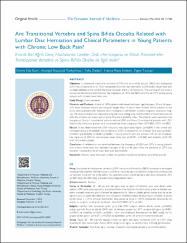| dc.contributor.author | Kurt, Emine Eda | |
| dc.contributor.author | Türkyılmaz, Ayşegül Küçükali | |
| dc.contributor.author | Dadalı, Yeliz | |
| dc.contributor.author | Erdem, Hatice Rana | |
| dc.contributor.author | Tuncay, Figen | |
| dc.date.accessioned | 2020-12-19T20:24:08Z | |
| dc.date.available | 2020-12-19T20:24:08Z | |
| dc.date.issued | 2016 | |
| dc.identifier.citation | Kurt, E.E., Turkyilmaz, A.K., Dadali, Y., Erdem, H.R., Tuncay, F. (2016). Are transitional certebra and spina bifida occulta related with lumbar disc herniation and clinical parameters in young patients with chronic low back pain?. Eurasian Journal of Medicine, 48(3), 177-180. https://app.trdizin.gov.tr/makale/TWpFMU9ETXdNQT09 | |
| dc.identifier.issn | 1308-8734 | |
| dc.identifier.issn | 1308-8742 | |
| dc.identifier.uri | https://app.trdizin.gov.tr/makale/TWpFMU9ETXdNQT09 | |
| dc.identifier.uri | https://hdl.handle.net/11436/4814 | |
| dc.description.abstract | Amaç: Lumbosakral transizyonel vertebra (LSTV) ve spina bifida okülta (SBO) lumbosacral omurgada sıklıkla görülür. Lomber disk herniasyonu (LDH) ve / veya bel ağrısı ile ilişkisinin varlığı mevcut literatürde tartışılmıştır ancak bir fikir birliği yoktur. Bu çalışmanın amacı, kronik bel ağrısı olan genç hastalarda LSTV ve SBO sıklığı ile LDH sıklığı arasındaki ilişkiyi değerlendirmektir.Çalışma tasarımı: Kesitsel.Gereç ve Yöntemler: 20 - 40 yaş arası bel ağrısı olan ve ağrısı 12 haftadan uzun süre devam eden toplam 1094 hasta çalışmaya alındı. Çalışmaya katılan tüm hastalar standart pelvis grafisi ve lomber vertebra manyetik rezonans görüntülemesi ile değerlendirildi. Ağrının şiddeti görsel analog skala ile ve bel ağrısının günlük yaşam aktivitelerine etkisi Oswestry dizabilite indeksi ile ölçülmüştür. Hastalar iki gruba ayrıldı: Grup 1, LDH'si olmayan hastalardan oluşuyordu ve Grup 2, LDH'li hastalardan oluşuyordu. Ek olarak, bu iki grup, üç alt gruba ayrılmıştır: Non-LSTV-SBO, LSTV ve SBO.Bulgular: Lomber disk herniasyon grubu grup 2'de LSTV sıklığının anlamlı olarak yüksek (p=0.004) olduğu görüldü. Buna ek olarak LDH'lı olan ve olmayan grupta da LSVT varlığının bel ağrısı (p<0.001, p<0.001) ve dizabilite (p<0.001, p<0.001) riskini arttırmaktaydı. Bununla birlikte SBO varlığı, her iki grupta da bel ağrısını (p=0.251, p=0.200) ve dizabiliteyi (p=0.134, p=0.161) arttırmamaktadır.Sonuç: Yaşları 20 - 40 arasında değişen kronik bel ağrısı olan genç hastalarda, LDH ve LSTV sıklığı arasında bir ilişki saptanmıştır. Ayrıca, LSTV varlığının bel ağrısı ve sakatlık riskini arttırdığı görülmüştür | en_US |
| dc.description.abstract | Objective: Lumbosacral transitional vertebra (LSTV) and spina bifida occulta (SBO) are widespread within the lumbosacral spine. Their connection to lumbar disc herniation (LDH) and/or lower back pain has been debated in the current literature; however, there is no consensus. The purpose of this study is to evaluate the relationship between the frequency of LSTV and SBO with that of LDH among young patients with chronic lower back pain.Study Design: Cross-sectional.Materials and Methods: A total of 1094 patients with lower back pain, aged between 20 and 40 years, with lower back pain history persisting for longer than 12 weeks were studied. All the patients in the study were evaluated with standard pelvic radiographs and lumbar vertebra magnetic resonance imaging. The severity of pain was measured using the visual analog scale, and the effect of lower back pain on daily life activities was measured using the Oswestry disability index. The patients were separated into two groups: Group 1 consisted of patients without LDH, and Group 2 consisted of patients with LDH. Additionally, these two groups were separated into three subgroups: Non-LSTV-SBO, LSTV, and SBO. Results: It was determined that LSTV frequency was significantly higher (p=0.004) in the lumbar disc herniation group 2. In addition, the existence of LSTV increased the risk of lower back pain (p<0.001, p<0.001) and disability (p<0.001, p<0.001) in young patients with and without LDH or not. However, the presence of SBO did not increase lower back pain (p=0.251, p=0.200) and disability (p=0.134, p=0.161) in both groups.Conclusion: A relationship was detected between the frequency of LDH and LSTV in young patients with chronic lower back pain between the ages of 20 and 40 years. Also, the presence of LSTV was found to increase the risk of lower back pain and disability | en_US |
| dc.language.iso | eng | en_US |
| dc.rights | info:eu-repo/semantics/openAccess | en_US |
| dc.subject | Genel ve dahili tıp | en_US |
| dc.subject | Chronic lower back pain | en_US |
| dc.subject | Lumbar discopathy | en_US |
| dc.subject | Transitional vertebra | en_US |
| dc.subject | Spina bifida occulta | en_US |
| dc.title | Are transitional certebra and spina bifida occulta related with lumbar disc herniation and clinical parameters in young patients with chronic low back pain? | en_US |
| dc.title.alternative | Kronik bel ağrılı genç hastalarda lomber disk herniasyonu ve klinik parametreler transizyonel vertebra ve spina bifida okülta ile ilgili midir? | en_US |
| dc.type | article | en_US |
| dc.contributor.department | RTEÜ, Tıp Fakültesi, Dahili Tıp Bilimleri Bölümü | en_US |
| dc.contributor.institutionauthor | Türkyılmaz, Ayşegül Küçükali | |
| dc.identifier.volume | 48 | en_US |
| dc.identifier.issue | 3 | en_US |
| dc.identifier.startpage | 177 | en_US |
| dc.identifier.endpage | 180 | en_US |
| dc.ri.edit | oa | en_US |
| dc.relation.journal | Eurasian Journal of Medicine | en_US |
| dc.relation.publicationcategory | Makale - Uluslararası Hakemli Dergi - Kurum Öğretim Elemanı | en_US |


















